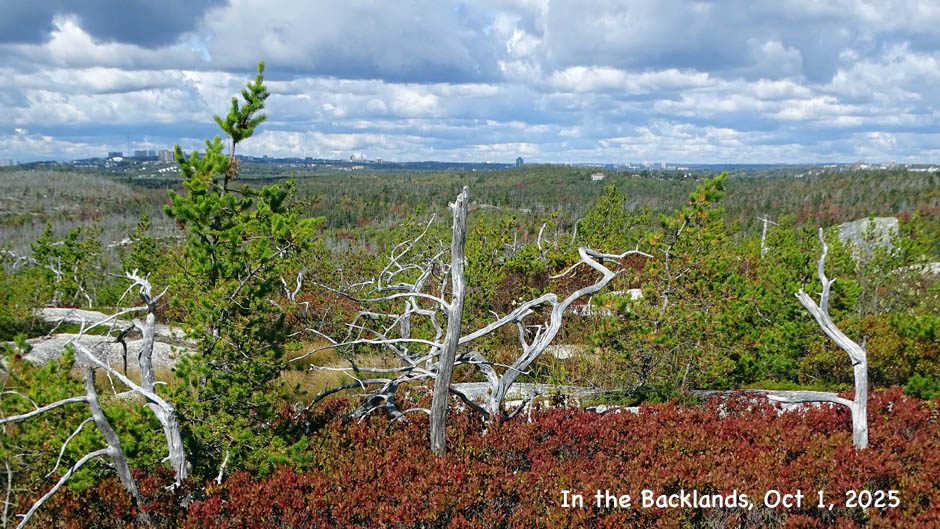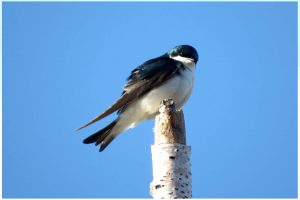‘drafting….
ECOLOGY WORKSHOP PAGES 1. Introduction (DP) 1. Introduction (DP)Whats there? – 2. Homework (DP) – 3. Overview of Environmental Factors (DP) – 4. JP-Crowberry Barrens & Fire Mgmt (DP) —-> 5. Forest Birds (This Page) (JBD) – 6. Specialist Birds (FL) – 7. Some Conservation Perspectives (KM) – 8. Discussion Synthesis – 8. Highlights – 9. Threats & Challenges |
Birders Joshua Barss Donham and Fulton Lavender collaborated to prepare some comments on the Birds in the Backlands: Indicators of the Health of the Habitat. Joshua focused on forest birds (on this page), and Fulton on ‘the Specialists’ (Goatsuckers and Raptors)
Joshua Barss Donham:

Red-breasted Nuthatch, an old forest species,
in the stands of old pine near the Williams
Lake Dam in theShaw Wilderness Park where
they nest.
In their April 2022 issue, Nature Ecology and Evolution featured a paper, “Forest degradation drives widespread avian habitat and population declines” – Matthew G. Betts et al., 2022, about how reduction in old forest leads to population decline and diversity of bird species in eastern Canada.
The paper looks at 54 common forest-associated bird species in the Maritime provinces*
Forty of the 54 these species were observed in the Backlands during the 2021 species survey and since.
There is evidence that 33 of those same species nest in the Backlands, including 6 species characteristic of immature forest, 14 characteristic of regenerating forest and 13 characteristic of mature (old) forest.
Some examples

Warblers Left to right: Northern Parula (M) Common Yellowthroat (R) & Yellow-rumped (M) M=Mature Forest, R= Regenerating Forest (from Betts et al., 2021)
There are many warblers that nest in the Backlands; Blackburnian Warbler, Magnolia, Chestnut-sided warblers and others.
The Northern Parula make their nests in Usnea lichen (old-man’s-beard) which grows on mature trees. Parulas nest in some of the large spruce that grow near the head of the trail that begins at the end of Princeton Avenue in Spryfield
The Common Yellowthroat Warbler in the photo is collecting insects in the shrubs growing along the path to the swimming spot at East Pine Island Pond, to take back to its nestlings.
Yellow-rumped Warblers also nest at East Pine Island Pond. The one in the photo above has has found itself a perch on a jack pine cone.
The young Hermit Thrush shown at right was observed during the species survey in August of 2021 on the Military Road. The trail that begins at the end of Princeton Avenue is actually what is often referred to as the Military Road, the remnants of an old road running right through the Backlands connecting Fergusons Cove with the Herring Cove Road.
Walking out the Military Road, I almost always hear Hermit Thrush calling.
The first time I heard Hermit Thrushes in the Backlands was with Fulton at East Pine Island Pond, early in the morning and across the water from the far side of the Pond, an ethereal sound that everyone should hear.
There are also a few Swainson’s thrushes in the Backlands, and, of course, plenty of robins.
This fledgling Winter Wren was seen on the trail at Princeton Avenue. After the trail comes out onto the barrens where one has a wide view of the valley through which the lower MacIntosh Run flows, the trail continues down into the valley. In a spot where there are some large pines, snags and a tangle of logs, just before the trail crosses the Run which is bordered by some large red maples, this wren popped out … right where one would expect to find wrens to nest if one were looking for them.
One conclusion from the bird observations: there are enough old trees and other components of Old Forests in the Backlands to support a good number of the old forest bird species cited in this recent paper.
There are of course many other groups of bird species in the Backlands. This is one of the Tree Swallows that nest near East Pine Island Pond.
Much could be said about the birds associated with the lakes, ponds and other wetlands: Red-winged Blackbird, Spotted Sandpiper, and American Woodcock. Then there are the Black ducks, the Mallards, and Green-winged teals and, thinking of Williams Lake, the loons.
Fulton Lavender talks about the specialists.
Between data collected in survey field trips in Spring/Summer 2021 and ebird reports during the same period, close to a hundred species of birds were observed in the Backlands.




